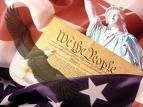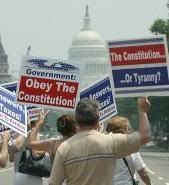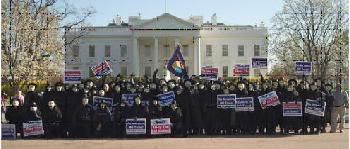From The Reader Comments
Finally one brave lawyer has broken his oath of secrecy and has taken a stand for all of us.
Finally, one brave New Hampshire man and wife have declared "enough is enough" and are refusing to budge till they are accorded their constitutional rights to due process of law and a fair trial.
We must support these brave pioneers and join their efforts if this nation is to survive and avoid total slavery of the masses. The "we" is all of us, and the time is NOW.
Read more in the reader comments here.












1 Comments:
Tax laws are clearly in derogation of personal rights and property interests and are, therefore, subject to strict construction, and any ambiguity must be resolved against imposition of the tax. In Billings v. U.S., 232 U.S. 261, 34 S.Ct. 421 (1914), the Supreme Court clearly acknowledged this basic and long-standing rule of statutory construction:
"Tax statutes . . . should be strictly construed, and, if any ambiguity be found to exist, it must be resolved in favor of the citizen. Eidman v. Martinez, 184 U.S. 578, 583; United States v. Wigglesworth, 2 Story, 369, 374; Mutual Benefit Life Ins. Co. v. Herold, 198 F. 199, 201, aff'd 201 F. 918; Parkview Bldg. Assn. v. Herold, 203 F. 876, 880; Mutual Trust Co. v. Miller, 177 N.Y. 51, 57."
(Id at p. 265, emphasis added)
Again, in United States v. Merriam, 263 U.S. 179, 44 S.Ct. 69 (1923), the Supreme Court clearly stated at pp. 187-88:
"On behalf of the Government it is urged that taxation is a practical matter and concerns itself with the substance of the thing upon which the tax is imposed rather than with legal forms or expressions. But in statutes levying taxes the literal meaning of the words employed is most important, for such statutes are not to be extended by implication beyond the clear import of the language used. If the words are doubtful, the doubt must be resolved against the Government and in favor of the taxpayer. Gould v. Gould, 245 U.S. 151, 153."
(emphasis added)
This rule of strict construction against the taxing authority was reiterated in Tandy Leather Company v. United States, 347 F.2d 693 (5th Cir. 1965), where Judge Hutcheson of our 5th Circuit eloquently and unequivocally proclaimed at p. 694-5:
". . . In ruling as he did, that the taxpayer had the obligation to show that sales of the articles in suit were not subject to the excise taxes collected, the district judge was misled by the erroneous contention of the tax collector into misstating the rule of proof in a tax case. This is: that the burden in such a case is always on the collector to show, in justification of his levy and collection of an excise tax, that the statute plainly and clearly lays the tax; that, in short, the fundamental rule is that taxes to be collectible must be clearly laid.
"The Government's claim and the judge's ruling come down in effect to the proposition that the state of construction of appellants' kits had reached such an advanced level that the tax levied on the finished products could be collected on their sale, though none had been clearly laid thereon by statute. Shades of Pym and John Hampden, of the Boston tea party, and of Patrick Henry and the Virginians! There is no warrant in law for such a holding. Gould v. Gould, 245 U.S. 151, at p. 153, 38 S.Ct. 53, 62 L.Ed. 211. In 51 American Jurisprudence, "Taxation", Sec. 316, "Strict or Liberal Construction", supported by a great wealth of authority, it is said:
'Although it is sometimes broadly stated either that tax laws are to be strictly construed or, on the other hand, that such enactments are to be liberally construed, this apparent conflict of opinion can be reconciled if it is borne in mind that the correct rule appears to be that where the intent of meaning of tax statutes, or statutes levying taxes, is doubtful, they are, unless a contrary legislative intention appears, to be construed most strongly against the government and in favor of the taxpayer or citizen. Any doubts as to their meaning are to be resolved against the taxing authority and in favor of the taxpayer. * * *'
"The judgment was wrong. It is, therefore, reversed and the cause is remanded with directions to enter judgment for plaintiffs and for further and not inconsistent proceedings."
(emphasis is the Court's)
See also: Gould v. Gould, 245 U.S. 151, 38 S.Ct. 53, 153 (1917); Royal Caribbean Cruises v. United States, 108 F.3d 290 (11th Cir. 1997); B & M Company v. United States, 452 F.2d 986 (5th Cir. 1971); Kocurek v. United States, 456 F. Supp. 740 (1978); Norton Manufacturing Corporation v. United States, 288 F. Supp. 829 (1968); Grays Harbor Chair and Manufacturing Company v. United States, 265 F. Supp. 254 (1967); Russell v. United States, 260 F. Supp. 493 (1966).
Thus, as we enter into the labyrinth of the Internal Revenue Code and its related regulations, we must do so mindful of the hornbook rule that tax laws are strictly construed and that when the letter of the law is subject to more than one interpretation, it must be construed against the imposition of the tax, the rule of interpretation of taxes being:
"that the burden in such a case is always on the collector to show, in justification of his levy and collection of an excise tax, that the statute plainly and clearly lays the tax; that, in short, the fundamental rule is that taxes to be collectible must be clearly laid." Tandy Leather Company, supra, at 694.
Post a Comment
Subscribe to Post Comments [Atom]
<< Home